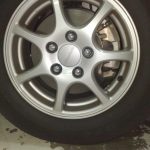 We all know that proper tire inflation is important. The big question is, what is the right tire pressure? Under-inflation leads to premature tire wear and increases rolling resistance (and hence decreased fuel efficiency). Over-inflation, on the other hand, may lead to decreased grip on the road. My Honda Stream has been running under-inflated for some time. At my last servicing, I had instructed the service centre to have my tires inflated to 250 KPa. I suspected the message didn’t get across.
We all know that proper tire inflation is important. The big question is, what is the right tire pressure? Under-inflation leads to premature tire wear and increases rolling resistance (and hence decreased fuel efficiency). Over-inflation, on the other hand, may lead to decreased grip on the road. My Honda Stream has been running under-inflated for some time. At my last servicing, I had instructed the service centre to have my tires inflated to 250 KPa. I suspected the message didn’t get across.
I’ve been meaning to get the pressure checked, but because I’ve filled the tires with nitrogen gas, I cannot just pull up to petrol station to fill the tires. Unless I fork out more money, I’d have to go back to the same place I got the original nitrogen inflation. That’s how it works for Kah Motors, and that’s how it works at AutoBacs too.
So I eventually fond time to visit a Kah Motors service centre. The service advisor, funnily enough, thought I was just a blur driver who didn’t know how to check my tire pressure, and directed me to drive over to the petrol station’s normal air pump. I pointed out my tire was nitrogen filled, before my car was “admitted” into the service bay near the nitrogen pump machine.
I asked to have my tires inflated to 250 KPa. The manufacturer’s recommendation is 220 KPa. I had suspected my tires were previously inflated to 220 KPa (I was right), and I felt it was too soft, and my sixth sense tells me it was bring down my fuel efficiency.
Why 250 KPa? Because 230 KPa is too little difference to have any appreciable effect. 240 KPa might be right, but why not just push it a little further. Afterall, some of the nitrogen will leak out over time, and if I can’t wait, I can always bleed out some of it anyway. Yeah, nothing very scientific about how the number was chosen.
The ride was pretty bumpy the first few days. But now it seems quite okay. Maybe I’ve gotten used to it.
View Comment Policy